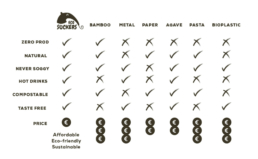
It takes at least 200 years for a plastic straw to biodegrade. Usually it’s only been used for 20 minutes. A moment on your lips, forever on the planet’s hips. As many as 8.3 billion plastic straws pollute the world’s beaches. 90% of seabirds have eaten plastic waste. Just 9% of it was recycled globally between 1950 and 2015. While the paper industry uses 35% of the total trees cut down each year. That’s 4 billion trees. 70% of the world’s paper comes from shrinking forests, not tree plantations or recycling.

Wheat is the answer
Natural wheat stems are the original straw, made of, well, straw – who’d have thought? Grown by nature, using hardly any of its resources, they don’t get soggy, taste or smell, and can be used in scalding hot drinks. Hot damn.

The greatest sucker on earth*
Along with Clive (our handsome anteater) and us humans, of course. *Yes it’s a big claim and we haven’t verified it…yet. But just look at all the evidence below.
1. Wheat straws help the planet
They’re a straw that’s grown by nature to make flour without chemicals or pesticides (we just use the discarded stems). The usual way is to create a plastic tube to resemble natural straw in a huge factory, using a lot of electricity and producing a load of waste. Then call it: a straw.
That seems a bit silly, right? Back before the paper straw was invented in 1888, people used rye-grass or hollow reed straws. It’s not a new idea, it’s a natural one. The difference is we now clean the stems in sterile water and air dry them, so they’re such a great sucker, there’s no need for paper or plastic. Progress, right?
It’s friendly single-use
Is that really a thing?
Yes, actually, it is.We’re single-use, and proud of it.
You see, single-use can be better when:

It’s not made from plastic or paper, but grown in the ground

Uses minimal resources and processing

When thrown away it biodegrades simply and easily.
Don’t get us wrong, we love most things being reusable. Yet when it comes to straws, it’s not the best solution. Metal, bamboo and glass straws need maintenance: constant cleaning and checking, which takes time, then to replace them it’s a much higher cost than with single-use straws. Not to mention the effect on the planet. A tonne of energy and resources are used to produce them, releasing a heap of greenhouse gases.
That said, if someone wants to reuse our straws, it’s possible, we do, we just wouldn’t recommend it for hospitality, simply due to hygiene.
2. Wheat straws help you
Why should your customers suck less? They want eco-values, sure, but they also want the best drinking experience a straw can offer. Thankfully Ecosuckers bring you both.

You’ll suck more with our suckers
We have the widest natural straws on the market, at an affordable price. They’re between 5-8mm (varies a little as nature’s not uniform), while most of the others are between 3-7mm – tried drinking a thick milkshake or a mojito with a 3mm straw?

Don’t get soggy in cold or hot drinks
We’ve carried out serious extensive research, on our own cold and hot drinks. Re-using the same Ecosuckers for a whole week in cold drink after hot drink, they never got soggy or changed in any way. (If you’d like to know why, it’s because they’re naturally non-porous, so don’t have microscopic holes in them.)

Competitively priced
Our straws are grown and made in China, which we understand some people might not like, but they’re never air-freighted, and it means you get great value for money. Right now there’s just nowhere else we can viably make Ecosuckers – but when there is, we’ll be there.

No taste or smell
After the whole week of being used again and again, they didn’t taste or smell, unlike reusable bamboo straws.
3. Eco-suckers V other straws
Let’s go head-to-head with the other types of alternative straws.


A by-product of wheat crops that are grown for flour. The leftover stalks are de-husked and trimmed by hand, cleaned with sterile water and air dried, using minimal resources and processing. They biodegrade or compost like any other organic material, giving nutrients back to the earth. They can be used in cold and hot drinks, are taste-free, and don’t have to be cleaned as they’re friendly single-use.

A by-product of wheat crops that are grown for flour. The leftover stalks are de-husked and trimmed by hand, cleaned with sterile water and air dried, using minimal resources and processing. They biodegrade or compost like any other organic material, giving nutrients back to the earth. They can be used in cold and hot drinks, are taste-free, and don’t have to be cleaned as they’re friendly single-use.

A by-product of wheat crops that are grown for flour. The leftover stalks are de-husked and trimmed by hand, cleaned with sterile water and air dried, using minimal resources and processing. They biodegrade or compost like any other organic material, giving nutrients back to the earth. They can be used in cold and hot drinks, are taste-free, and don’t have to be cleaned as they’re friendly single-use.
Bioplastic
Not as eco-friendly as you might think. To break down, it needs special conditions only available in industrial composting facilities, but very few cities have these. So it ends up in landfill and takes years to decompose, releasing methane, a greenhouse gas that’s 23 times more potent than carbon dioxide.
Bamboo
Again, not as green as they might seem. Lots of energy and resources are used to produce them, and the process releases greenhouse gases. In fact, they must be reused at least 32 times to compensate for the energy that’s been used to make them. That’s a lot of wear and tear to go through.
Agave
On the surface, these appear environmentally friendly.
Yet a deeper look shows that the agave fibres are turned into something called a BSP agave compound, while a biodegradation additive is added (whatever that is). Although we’re not sure what a BSP compound is, we do know that a well-known tequila brand has developed their own agave straws with a bio-based composite, which biodegrades in 5 years, yet is still made of 69% plastic (so all the negatives of plastic production come with these). The reason for this is because if they contained only agave fibres, the straws would break. So although other brands of agave bio straws might not claim they have plastic in them, there’s a question mark over what the agave compound is made of, or what their durability is like.
Metal
When it comes to carbon emissions, producing one metal straw is the same as making 150 plastic ones. You need to reuse a metal straw at least 150 times to break even on the environmental cost of its production. In terms of personal use, this means taking it everywhere with you, especially out clubbing. For wholesale, there’s a lot of cleaning and checking for scratches and other damage – stainless steel is not resistant to heat or the acid from drinks such as lemonade. Medical stainless steel versions are more resistant, yet much pricier.
Paper
Paper straws aren’t a friendly single-use product. They need more energy and resources to manufacture than plastic. And if food residue is left on them, they can’t be recycled, so are sent to landfill or are ‘converted into energy’, which means they’re burned, causing pollution and greenhouse gases.
Pasta
The main problem with the pasta straw is that you can’t use it in a hot drink, as the heat ‘cooks’ the pasta and turns the straw soft and mushy. There’s also a subtle flavour of dried pasta when you’re drinking water. Its big durability claim is that it lasts longer than paper or card, which means it sees its key rivals as the soggiest straws around. Plus, as it’s food, its shelf life is around a year, which might not be handy if you want to stock up. So we praise the pasta straw for its eco-credentials, but not its business canniness.
For smart, green suckers
Smart, green suckers need a smart, green sucker. It doesn’t go soggy leaving a mess in your drink, and doesn’t leave a mess of the planet. So, go get yours. Shop our natural wheat straws here.
For smart, green suckers
Smart, green suckers need a smart, green sucker. It doesn’t go soggy leaving a mess in your drink, and doesn’t leave a mess of the planet. So, go get yours. Shop our natural wheat straws here.

